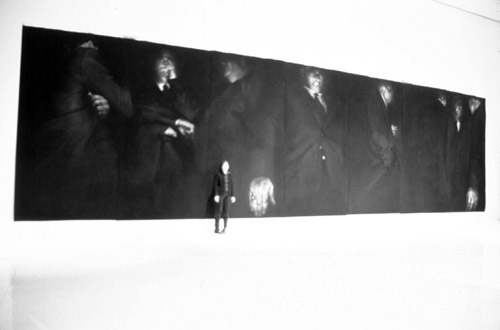Business of Art: Essential Services for Aging Artists
Melanie Baker standing with In the Company of Men (2001). Charcoal on paper.
How does a visual artist age and still remain active? What are the distinct disadvantages to being an older artist, and what are some of the behavioral patterns that might lead to such disadvantages? A group of graduate students at Carnegie Mellon University has recently taken on these questions in a report that outlines the needs of aging visual artists and recommends several changes that may help older artists with specific challenges they’re likely to face.
Because of the evidence that a long-term practice of visual art may cause a variety of problems for artists after retirement, ten students at the H. John Heinz III School of Public Policy and Management at Carnegie Mellon University developed a group research project this past spring called Essential Services for Aging Artists (ESAA) to thoroughly examine the issue. The project’s goals were to gain an understanding of the problems and needs that visual artists face as they age, to research potential services that currently exist to address these needs, to pinpoint needs still unaddressed, and to make recommendations for addressing these needs. The ESAA project’s final report details the current “state of the artist” and the needs of artists in eight essential service categories: housing, estate planning, business skills, archiving, legal services, retirement, insurance, and health care.
General ESAA Findings
ESAA’s research regarding the service categories important to the welfare of visual artists revealed a few themes that were incorporated into the report’s conclusions and recommendations. The most important theme was the need for artists to become educated in the service categories available to them. ESAA’s survey repeatedly revealed that many artists have limited knowledge about the full range of services currently available to assist them with career and life challenges. In the report, therefore, we suggest strongly that artists take more initiative in obtaining information about crucial needs they will face and accessing services to address those needs. NYFA Source, NYFA’s database of services, grants, and publications for artists includes extensive listings of various available services. The ESAA report also recommends to service providers that they implement more effective marketing of their services to cater specifically to artists.
This leads to another important theme revealed in our research: the practice of visual art typically demands that artists spend long hours alone in a studio. This has important ramifications. For instance, ESAA’s survey of visual artists revealed that 24.3% of 1,150 respondents felt somewhat set apart from other people and that 7.4% felt very set apart. A 75 year-old female painter who participated in the New York focus group said as much: “In not being joiners, we are holed up in our own studios.” In Pittsburgh, a male painter, agreed, responding, “It’s not negative. I think [being alone] is a professional hazard.”
While the practice of visual art may create strong, independent, and individualistic thinkers, it also seems to create an almost institutional aversion toward working with others. This aversion is particularly troublesome, because, as independent contractors, visual artists typically are forced to take control of planning for their retirement, for drafting contracts and running a business, and for attending to all other personal matters. In other arts disciplines such as theater, dance, and music, collaboration is necessary and constant, and practitioners are therefore more prone to collectivizing and tapping into a community to help solve their problems. Not so for the average visual artist.
Recommendation to Visual Artists: Join a Community
Becoming part of a network of artists or of the larger community can have important practical benefits for visual artists. Joining with others not only helps point artists to necessary services, but it also builds confidence, provides support, and leads to opportunities for networking. By joining a network, visual artists can take advantage of group rates for health insurance, educational workshops, and workspace opportunities. Strength in numbers could even allow a group of visual artists to have influence over arts organizations, communities, or local politics and decisions regarding issues important to artists.
Alyson Stanfield, an artists’ consultant, recommends in the essay “6 Habits of Highly Successful Artists” that visual artists join an artist organization because it “builds your confidence, provides emotional and professional support, and opens your eyes to opportunities you never knew existed.” Stanfield has written that 85-95% of artists get gallery shows because of a recommendation from “another artist, dealer, curator, collector, or other art world type.” Artist membership organizations, meanwhile, are an excellent way to gain practical benefits. Although many membership organizations charge yearly dues, the cost of the dues can be offset by group discounts on art supplies or on other services. In addition, these dues are also tax deductible. If no appropriate organization exists, Stanfield suggests doing something as simple as holding “artists’ salons,” informal gatherings where artists can share their work and discuss challenges they are facing.
Even if one believes that an artist should be focused on creating and exhibiting work, community involvement does not have to interfere with artistic practice, and the benefits far outweigh any disadvantages. Other artistic disciplines have strong centralized member organizations that benefit practitioners. Actors Equity, a labor union, guarantees minimum salaries for performers, additional pay for certain duties, fair working rules and conditions, insurance, and retirement planning. Musicians, all types of writers, and other theater professionals each have unions specific to their disciplines. Community involvement need not be limited to artistic organizations. In fact, one New York metalsmith noted that when he needed support it was more forthcoming from the community at-large than from his artist-friends or from institutions or service organizations. “Essentially,” he said, “through the support of the people in my apartment building, I put together a show and I sold a bunch of works…I was pleasantly surprised that there were so many individuals that were sensitive.”
The basic fact is, while it is difficult to sustain a career as a visual artist over the long run, there are plenty of places artists can turn to for help. The artist need only be willing to look outside the studio for that help.
Michael Fallon is an artist, arts writer, and arts organizer based in St. Paul, MN. He became interested in the topic of aging visual artists after writing several profiles on such artists in Minneapolis, Kansas City, Los Angeles, and several other cities. While a student this past year in the Master of Arts Management program at Carnegie Mellon University, Fallon served as the project leader of the Essential Services for Aging Artists study.





